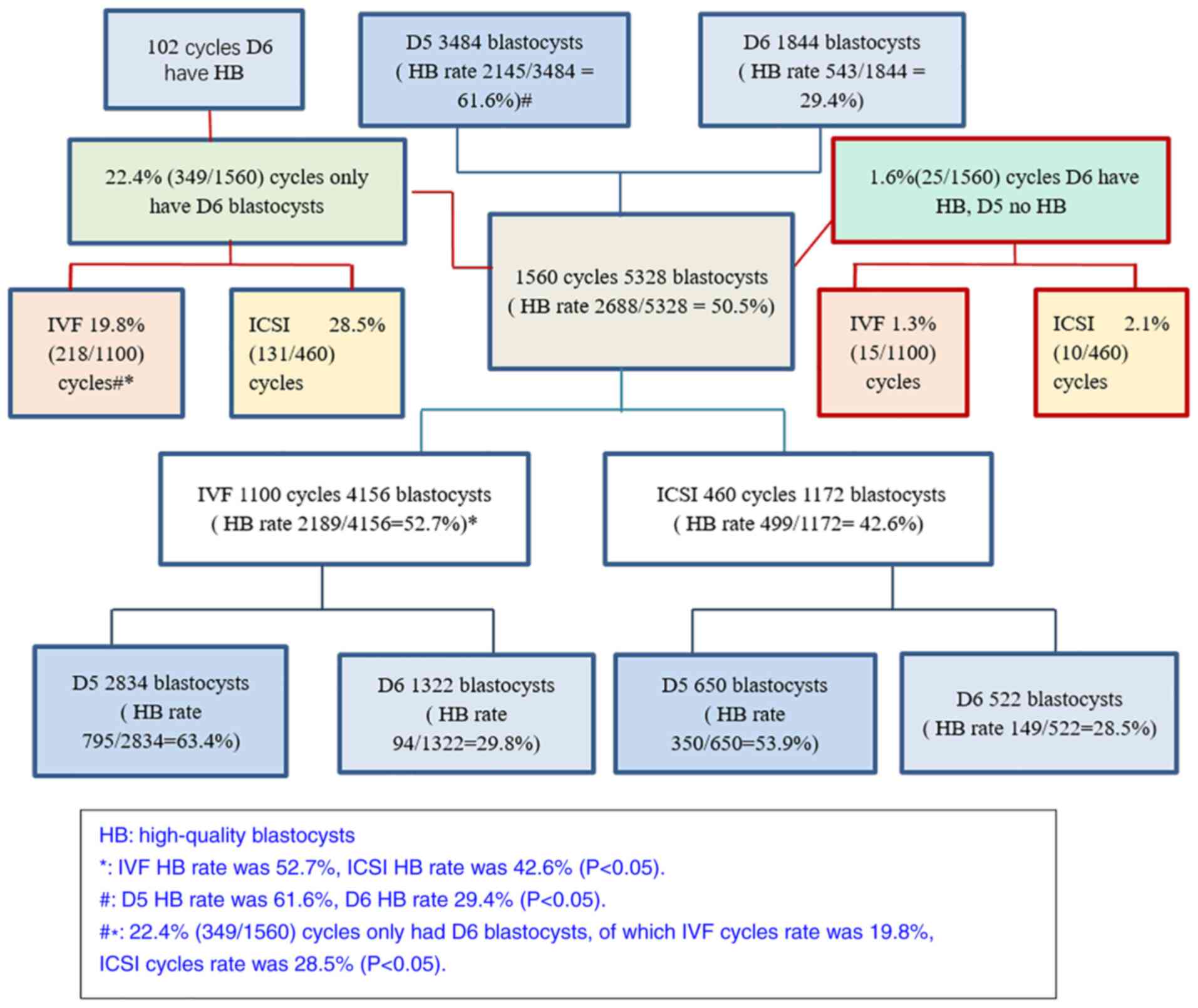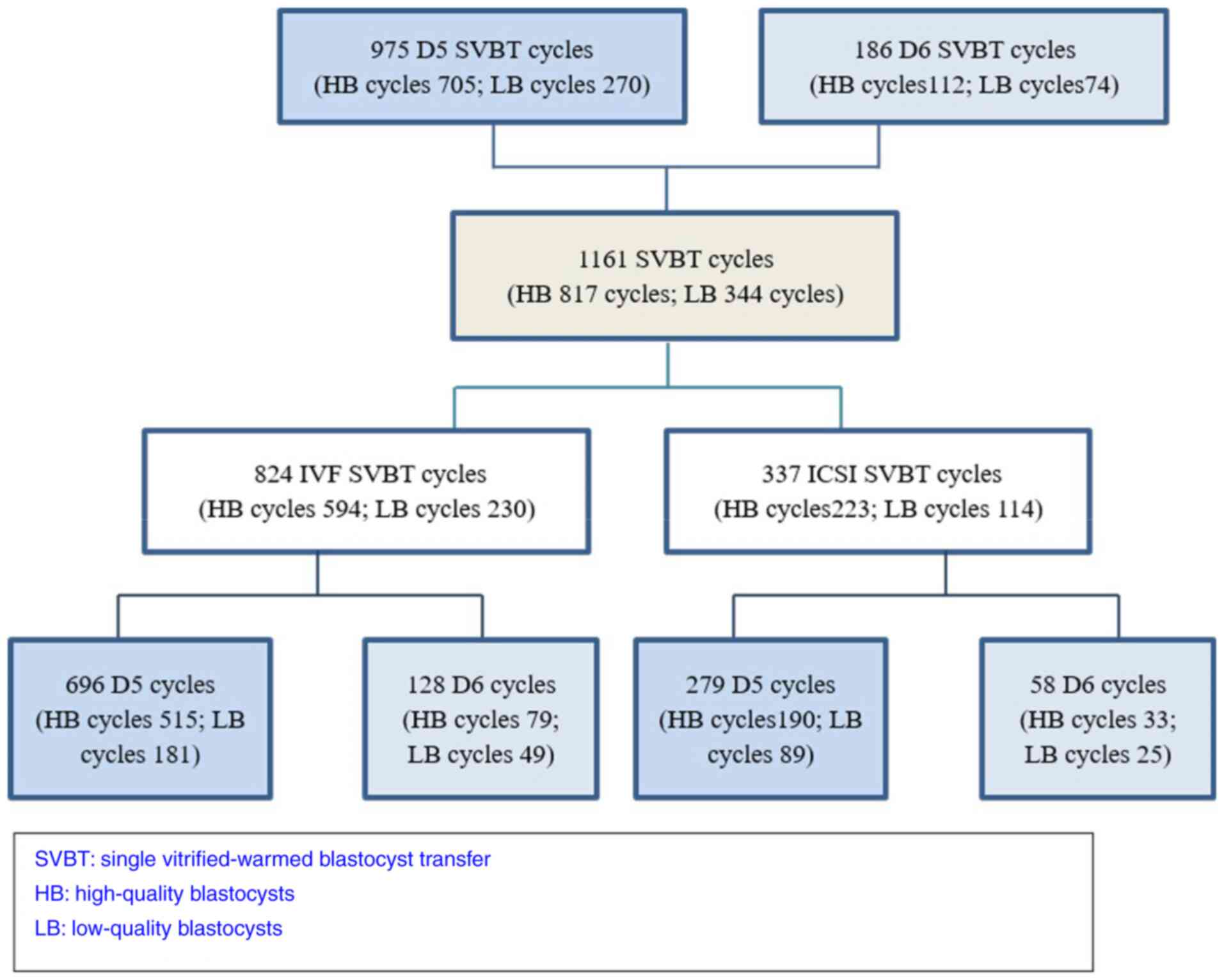|
1
|
Revelli A, Canosa S, Carosso A, Filippini
C, Paschero C, Gennarelli G, Delle Piane L and Benedetto C: Impact
of the addition of early embryo viability assessment to
morphological evaluation on the accuracy of embryo selection on day
3 or day 5: A retrospective analysis. J Ovarian Res.
12(73)2019.PubMed/NCBI View Article : Google Scholar
|
|
2
|
Glujovsky D, Farquhar C, Quinteiro Retamar
AM, Alvarez Sedo CR and Blake D: Cleavage stage versus blastocyst
stage embryo transfer in assisted reproductive technology. Cochrane
Database Syst Rev. 2016(CD002118)2016.PubMed/NCBI View Article : Google Scholar
|
|
3
|
Freeman MR, Hinds MS, Howard KG, Howard JM
and Hill GA: Guidance for elective single-embryo transfer should be
applied to frozen embryo transfer cycles. J Assist Reprod Genet.
36:939–946. 2019.PubMed/NCBI View Article : Google Scholar
|
|
4
|
Vega M, Zaghi S, Buyuk E and Jindal S: Not
all twins are monozygotic after elective single embryo transfer:
Analysis of 32,600 elective single embryo transfer cycles as
reported to the society for assisted reproductive technology.
Fertil Steril. 109:118–122. 2018.PubMed/NCBI View Article : Google Scholar
|
|
5
|
Reljič M and Porović A: Maternal serum
levels of angiogenic markers and markers of placentation in
pregnancies conceived with fresh and vitrified-warmed blastocyst
transfer. J Assist Reprod Gene. 36:1489–1495. 2019.PubMed/NCBI View Article : Google Scholar
|
|
6
|
Sciorio R, Thong KJ and Pickering SJ:
Increased pregnancy outcome after day 5 versus day 6 transfers of
human vitrified-warmed blastocysts. Zygote. 27:279–284.
2019.PubMed/NCBI View Article : Google Scholar
|
|
7
|
Kovalevsky G, Carney SM, Morrison LS,
Boylan CF, Neithardt AB and Feinberg RF: Should embryos developing
to blastocysts on day 7 be cryopreserved and transferred: An
analysis of pregnancy and implantation rates. Fertil Steril.
100:1008–1012. 2013.PubMed/NCBI View Article : Google Scholar
|
|
8
|
Hiraoka K, Hiraoka K, Miyazaki M, Fukunaga
E, Horiuchi T, Kusuda T, Okano S, Kinutani M and Kinutani K:
Perinatal outcomes following transfer of human blastocysts
vitrified at day 5, 6 and 7. J Exp Clin Assist Reprod.
6(4)2009.PubMed/NCBI
|
|
9
|
El-Toukhy T, Wharf E, Walavalkar R, Singh
A, Bolton V, Khalaf Y and Braude P: Delayed blastocyst development
does not influence the outcome of frozen-thawed transfer cycles.
BJOG. 118:1551–1556. 2011.PubMed/NCBI View Article : Google Scholar
|
|
10
|
Gardner DK, Lane M, Stevens J, Schlenker T
and Schoolcraft WB: Reprint of: Blastocyst score affects
implantation and pregnancy outcome: Towards a single blastocyst
transfer. Fertil Steril. 112 (4 Suppl 1):e81–e84. 2019.PubMed/NCBI View Article : Google Scholar
|
|
11
|
Yang H, Yang Q, Dai S, Li G, Jin H, Yao G
and Sun Y: Comparison of differences in development potentials
between frozen-warmed D5 and D6 blastocysts and their relationship
with pregnancy outcomes. J Assist Reprod Genet. 33:865–872.
2016.PubMed/NCBI View Article : Google Scholar
|
|
12
|
Jiang Y, Cao Q, Zhao X, Li L, Li S and Gao
F: Percutaneous epididymal sperm aspiration and short time
insemination in the treatment of men with obstructive azoospermia.
J Assist Reprod Genet. 30:1175–1179. 2013.PubMed/NCBI View Article : Google Scholar
|
|
13
|
Gardner DK and Schoolcraft WB: Culture and
transfer of human blastocysts. Curr Opin Obstet Gynecol.
11:307–311. 1999.PubMed/NCBI View Article : Google Scholar
|
|
14
|
Bourdon M, Pocate-Cheriet K, Finet de
Bantel A, Grzegorczyk-Martin V, Amar Hoffet A, Arbo E, Poulain M
and Santulli P: Day 5 versus day 6 blastocyst transfers: A
systematic review and meta-analysis of clinical outcomes. Hum
Reprod. 34:1948–1964. 2019.PubMed/NCBI View Article : Google Scholar
|
|
15
|
Sciorio R, Thong KJ and Pickering SJ:
Single blastocyst transfer (SET) and pregnancy outcome of day 5 and
day 6 human blastocysts vitrified using a closed device.
Cryobiology. 84:40–45. 2018.PubMed/NCBI View Article : Google Scholar
|
|
16
|
Behr B, Gebhardt J, Lyon J and Milki AA:
Factors relating to a successful cryopreserved blastocyst transfer
program. Fertil Steril. 77:697–699. 2002.PubMed/NCBI View Article : Google Scholar
|
|
17
|
Yoshida IH, Santos M, Berton CZ, Chiarella
CL, Tanada MS, BCordts E, Carvalho WP and Barbosa CP: Can
trophectoderm morphology act as a predictor for euploidy? JBRA
Assist Reprod. 22:113–115. 2018.PubMed/NCBI View Article : Google Scholar
|
|
18
|
Irani M, O'Neill C, Palermo GD, Xu K,
Zhang C, Qin X, Zhan Q, Clarke RN, Ye Z, Zaninovic N and Rosenwaks
Z: Blastocyst development rate influences implantation and live
birth rates of similarly graded euploid blastocysts. Fertil Steril.
110:95–102.e1. 2018.PubMed/NCBI View Article : Google Scholar
|
|
19
|
Ueno S, Berntsen J, Ito M, Uchiyama K,
Okimura T, Yabuuchi A and Kato K: Pregnancy prediction performance
of an annotation-free embryo scoring system on the basis of deep
learning after single vitrified-warmed blastocyst transfer: A
single-center large cohort retrospective study. Fertil Steril.
116:1172–1180. 2021.PubMed/NCBI View Article : Google Scholar
|
|
20
|
Ozgur K, Berkkanoglu M, Bulut H, Yoruk
GDA, Candurmaz NN and Coetzee K: Single best euploid versus single
best unknown-ploidy blastocyst frozen embryo transfers: A
randomized controlled trial. J Assist Reprod Genet. 36:629–636.
2019.PubMed/NCBI View Article : Google Scholar
|
|
21
|
Speyer B, O'Neill H, Saab W, Seshadri S,
Cawood S, Heath C, Gaunt M and Serhal P: In assisted reproduction
by IVF or ICSI, the rate at which embryos develop to the blastocyst
stage is influenced by the fertilization method used: A plit
IVF/ICSI study. J Assist Reprod Genet. 36:647–654. 2019.PubMed/NCBI View Article : Google Scholar
|
|
22
|
Cruz M, Garrido N, Gadea B, Muñoz M,
Pérez-Cano I and Meseguer M: Oocyte insemination techniques are
related to alterations of embryo developmental timing in an oocyte
donation model. Reprod Biomed Online. 27:367–375. 2013.PubMed/NCBI View Article : Google Scholar
|
|
23
|
Sauerbrun-Cutler MT, Huber WJ III, Has P,
Shen C, Hackett R, Alvero R and Wang S: Is intracytoplasmic sperm
(ICSI) better than traditional in vitro fertilization (IVF):
Confirmation of higher blastocyst rates per oocyte using a split
insemination design. J Assist Reprod Genet. 37:1661–1667.
2020.PubMed/NCBI View Article : Google Scholar
|
















